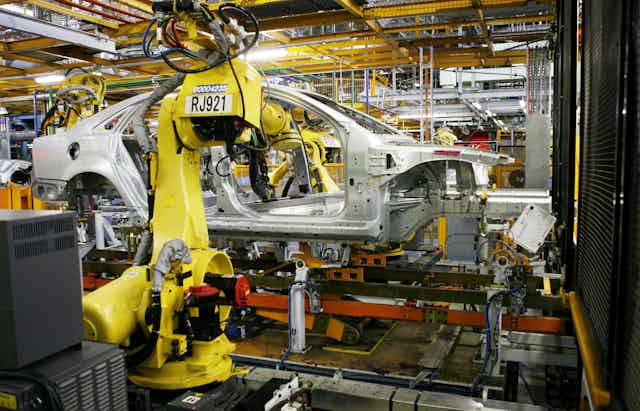Prime Minister Malcolm Turnbull’s 2015 National Innovation and Science Agenda was a call to arms for Australia’s research and industry sectors to collaborate and drive our economy.
One and a half years on, you’d be excused for thinking a few pages of notes were missing from Budget 2017. Specifically no comment was made about the vision of where our great “ideas boom” was taking us - setting the scene to unite industry and researchers alike.
For manufacturing there was a glimmer of hope in the announcement of A$100 million to boost innovation, skills and employment in advanced manufacturing.
It addresses people, know-how, process and partnerships. If connected into a strategic plan there could be benefits for businesses as the manufacturing sector redeploys into new activity.
However, it does appear narrowly focused on the here and now for closed and closing automotive manufacturers.
In the absence of linkage with the National Innovation and Science Agenda, the pending 2030 Roadmap from Innovation and Science Australia, and comment on the research and development tax incentive review, the A$100 million may be an expensive band-aid.
Capital upgrades
The funding announcement refers to A$47.5 million for a new Advanced Manufacturing Growth Fund to support South Australian and Victorian manufacturers for capital upgrades to “make their businesses more competitive through innovative processes and equipment”.
My experience of project work with manufacturing companies is that capital cost of equipment (capital expenditure, or “CapEx”) has never been a roadblock to growth and success.
When the business case stacks up, CapEx is easily justified. The business case is built upon having the right people and know-how in the business.
In isolation the drive to purchase new equipment presents no value to business, and may even lead to stranded assets. But coupled with people and know-how, opportunities may come.
It’s important to recognise that right now, existing manufacturers are looking at how to utilise and/or redeploy their existing assets. In particular the automotive parts manufacturers are seeking new opportunities that match with existing equipment.
An example is a company that I am working with, Precision Components in South Australia. They are redeploying their large metal presses previously used in car component manufacturing to create components for capturing solar energy at HeliostatSA. It’s a project that has contributed to export capability for HeliostatSA.
Redeployment is the focus for many businesses today, not new equipment.
Small scale research projects
The funding announcement refers to A$4 million to support small scale and pilot research projects in advanced manufacturing, administered through the Advanced Manufacturing Growth Centre.
This seems like a good move.
Boosting innovation requires broadening the base of businesses looking to grow, and collaboration with university research programs is one way to achieve this. Small grants build confidence in collaborative partnerships, and help to clarify what the innovation is and its future return on investment.
For example, the government’s Innovation Connections scheme has had success in seeding innovation and collaboration.
A recent recipient of an Innovation Connections grant, company Sentek Pty Ltd, is utilising this scheme to fund new product development, and to underpin justification for future and larger investment. I am collaborating with Sentek on this project.
Cooperative Research Centre (CRC) Projects
The funding announcement refers to A$20 million under the Cooperative Research Centre – Projects initiative for larger scale advanced manufacturing research projects.
This funding should be warmly received.
The CRC program links researchers and industry, with the aim of delivering economic value to the industry partner and the sector more broadly. This scheme funds the real costs of research, develops skills in people, and incentivises transitioning knowledge out of the university.
The newly formed CRC Projects scheme is in its infancy, with industry firmly in the driving seat for administering the projects.
From the first two rounds of funding under the CRC Projects, a total of 28 projects have been funded. Each project has seen a co-investment from industry, universities, other research institutes, and the federal government.
Crunching the numbers for the funded projects shows, on average, the government invested A$2.04 million per project. This indicates that the new A$20 million of funding could support around an additional ten projects. This will stimulate activity and add value to our advanced manufacturing sector.
Innovation Labs
The funding announcement refers to A$10 million to establish Innovation Labs in South Australia and Victoria to serve industry.
It’s difficult to know what this means in reality.
Perhaps the purpose is to provide facilities for early stage innovation to be tested at minimal expense, and reduce the risk of the business making significant investment in infrastructure.
Perhaps it will allow researchers or companies to shore up concepts before seeking investment and raising capital. Maybe existing facilities will seek financial support to expand their remit across a diverse advanced manufacturing sector.
A topical example relates to additive manufacturing – generally known as 3D printing. Businesses producing 3D-printed products need a testing ground to conduct certification and accreditation of products prior to sale. The Innovation Labs could fill this void, and complete the link between laboratory research and commercial product.
Engineering excellence
The funding announcement refers to A$5 million investment in engineering student research at universities, technology institutions and in industry to maintain the flow of highly trained engineers to the automotive design and engineering sector.
At the heart of innovation are people.
Engineers represent one discipline that contributes to the pipeline of innovation. An investment to see the continual training of excellent engineers may address the loss of traditional career pathways.
Perhaps the funds will aid in restructuring of engineering education towards emerging opportunities in the health and medical, agriculture, renewable energy and other sectors.
As more details come to light in the coming weeks and months, the Turnbull government’s vision for Australia’s manufacturing future may become clearer.
But the sense from the manufacturers themselves is that they will just get on and do it anyway.

